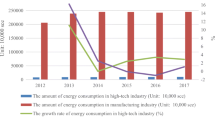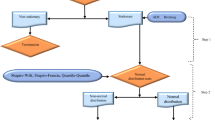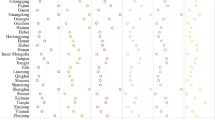Abstract
The influence of technology advancement on carbon dioxide (CO2) emissions is complex and controversial, yet existing literature ignores the level of economic development in regard to its influential effect. With the panel threshold regression model, this research investigates the marginal and non-linear impacts of technology advancement on CO2 emissions along with the changes of economic development and presents the heterogeneity between different countries. The results are as follows: First, technology advancement and CO2 emissions have a non-linear inverted U-shaped relationship, which is significantly affected by different levels of economic development. When economic development exceeds a certain threshold, the impact turns from positive to negative. Second, the impact varies remarkably among different countries. We provide evidence for inverted U-shaped and N-shaped correlations in the Organization for Economic Co-operation and Development (OECD) countries and high-income countries (non-OECD), respectively. Although technology advancement always promotes CO2 emissions in middle- and low-income countries, its marginal effect is decreasing. This study not only indicates the dynamic impacts of technology advancement on CO2 emissions in different countries, but also contributes to policymakers’ understanding of the “common but differentiated responsibilities” involved in mitigating CO2 emissions.


Similar content being viewed by others
Data availability
Data are available from the authors upon request.
References
Ahmad M, Khan Z, Rahman ZU, Khattak SI, Khan ZU (2019) Can innovation shocks determine CO2 emissions (CO2e) in the OECD economies? A new perspective. Econ Innov New Technol:1–21. https://doi.org/10.1080/10438599.2019.1684643
Ali W, Abdullah A, Azam M (2017) Re-visiting the environmental Kuznets curve hypothesis for Malaysia: fresh evidence from ARDL bounds testing approach. Renew Sust Energ Rev 77:990–1000
Andreoni V, Galmarini S (2016) Drivers in CO2 emissions variation: a decomposition analysis for 33 world countries. Energy 103:27–37
Ang JB (2007) CO2 emissions, energy consumption, and output in France. Energy Policy 35:4772–4778
Apergis N (2016) Environmental Kuznets curves: new evidence on both panel and country-level CO2 emissions. Energy Econ 54:263–271
Apergis N, Payne JE (2009) CO2 emissions, energy usage, and output in Central America. Energy Policy 37:3282–3286
Barrett S (2006) Climate treaties and “breakthrough” technologies. Am Econ Rev 96:22–25
Berkhout PHG, Muskens JC, Velthuijsen JW (2000) Defining the rebound effect. Energy Policy 28(6):425–432
Boden TA, Marland G, Andres RJ (2015) Global, regional, and national fossil-fuel CO2 emissions. Oak Ridge, Tenn., U.S.A.: Carbon Dioxide Information Analysis Center, Oak Ridge National Laboratory, U.S. Department of Energy. https://doi.org/10.3334/CDIAC/00001_V2015
Bosetti V, Carraro C, Galeotti M (2006) The dynamics of carbon and energy intensity in a model of endogenous technical change. Energy J 27:191–205
Brock WA, Taylor MS (2010) The green Solow model. J Econ Growth 15(2):127–153
Chang CP, Lee CC (2008) Are per capita carbon dioxide emissions converging among industrialized countries? New time series evidence with structural breaks. Environ Dev Econ 13(4):497–515
Chen Y, Lee CC (2020) Does technological innovation reduce CO2 emissions? Cross-country evidence. J Clean Prod 263:121550
Chen J, Gao M, Mangla SK, Song M, Wen J (2020) Effects of technological changes on China’s carbon emissions. Technol Forecast Soc Chang 153:119938
Cheng ZH, Li LS, Liu J (2018) Industrial structure, technical progress and carbon intensity in China’s provinces. Renew Sust Energ Rev 81:2935–2946
Dietz T, Rosa EA (1997) Effects of population and affluence on CO2 emissions. Proc Natl Acad Sci 94(1):175–179
Du K, Li J (2019) Towards a green world: how do green technology innovations affect total-factor carbon productivity. Energy Policy 131:240–250
Du K, Li P, Yan Z (2019) Do green technology innovations contribute to carbon dioxide emission reduction? Empirical evidence from patent data. Technol Forecast Soc Chang 146:297–303
Ehrlich PR, Holdren JP (1971) The impact of population growth. Science 171:1212–1217
Fare R, Grosskopf S, Norris M, Zhang Z (1994) Productivity growth technical progress and efficiency change in industrialised Countries. Am Econ Rev 84:66–83
Grossman GM, Krueger AB (1995) Economic growth and the environment. Q J Econ 110:353–377
Grubb M (2006) Technology innovation and climate change policy: an overview of issues and options. Keio Econ Stud 41:103–132
Hall RE, Jones CI (1999) Why do some countries produce so much more output than others? Q J Econ 114:83–116
Hansen BE (1999) Threshold effects in non-dynamic panels: estimation, testing, and inference. J Econ 93:345–368
Hao Y, Wang L, Lee CC (2020) Financial development, energy consumption and China’s economic growth: new evidence from provincial panel data. Int Rev Econ Financ 69:1132–1151
Hayashi D (2018) Knowledge flow in low-carbon technology transfer: a case of India’s wind power industry. Energy Policy 123:104–116
Huang J, Liu Q, Cai X, Hao Y, Lei H (2018) The effect of technological factors on China’s carbon intensity: new evidence from a panel threshold model. Energy Policy 115:32–42
Jaforullah M, King A (2017) The econometric consequences of an energy consumption variable in a model of CO 2 emissions[J]. Energy Econ 63:84–91
Jordaan SM, Romo-Rabago E, Mcleary R et al (2017) The role of energy technology innovation in reducing greenhouse gas emissions: a case study of Canada. Renew Sustain Energy Rev 78:1397–1409
Kasman A, Duman YS (2015) CO2 emissions, economic growth, energy consumption, trade and urbanization in new EU member and candidate countries: a panel data analysis. Econ Model 44:97–103
Khattak SI, Ahmad M, Khan ZU, Khan A (2020) Exploring the impact of innovation, renewable energy consumption, and income on CO2 emissions: new evidence from the BRICS economies. Environ Sci Pollut Res 27:13866–13881
Le HP, Ozturk I (2020) The impacts of globalization, financial development, government expenditures, and institutional quality on CO 2 emissions in the presence of environmental Kuznets curve. Environ Sci Pollut Res 27:22680–22697
Lee CC, Chiu YB (2011) Electricity demand elasticities and temperature: evidence from panel smooth transition regression with instrumental variable approach. Energy Econ 33(5):896–902
Lee CC, Chiu YB, Sun CH (2010) The environmental Kuznets curve hypothesis for water pollution: do regions matter? Energy Policy 38(1):12–23
Lee CC, Wang CW, Ho SJ (2020) The impact of natural disaster on energy consumption: international evidence. Energy Econ:105021. https://doi.org/10.1016/j.eneco.2020.105021
Li K, Lin B (2015) Impacts of urbanization and industrialization on energy consumption/CO2 emissions: does the level of development matter? Renew Sust Energ Rev 52:1107–1122
Li K, Lin B (2016) Heterogeneity analysis of the effects of technology progress on carbon intensity in China. Int J Clim Change Strat Manag 8(1):129–152
Li M, Wang Q (2017) Will technology advances alleviate climate change? Dual effects of technology change on aggregate carbon dioxide emissions. Energy Sustain Dev 41:61–68
Liddle B (2013) Population, affluence, and environmental impact across development: evidence from panel cointegration modeling. Environ Model Softw 40:255–266
Lin B, Liu X (2012) Dilemma between economic development and energy conservation: energy rebound effect in China. Energy 45:867–873
Liu TY, Lee CC (2020) Convergence of the world’s energy use. Resour Energy Econ 62:101199
Madlener R, Sunak Y (2011) Impacts of urbanization on urban structures and energy demand: what can we learn for urban energy planning and urbanization management? Sustain Cities Soc 1(1):45–53
Managi S, Hibiki A, Tsurumi T (2009) Does trade openness improve environmental quality? J Environ Econ Manag 58(3):346–363
Moutinho V, Varum C, Madaleno M (2017) How economic growth affects emissions? An investigation of the environmental Kuznets curve in Portuguese and Spanish economic activity sectors. Energy Policy 106:326–344
Nasir MA, Huynh TLD, Tram HTX (2019) Role of financial development, economic growth & foreign direct investment in driving climate change: a case of emerging ASEAN. J Environ Manag 242:131–141
Nguyen TT, Pham TAT, Tram HTX (2020) Role of information and communication technologies and innovation in driving carbon emissions and economic growth in selected G-20 countries. J Environ Manag 261:110162
Pham NM, Huynh TLD, Nasir MA (2020) Environmental consequences of population, affluence and technological progress for European countries: a Malthusian view. J Environ Manag 260:110143
Rafiq S, Salim R, Nielsen I (2016) Urbanization, openness, emissions, and energy intensity: a study of increasingly urbanized emerging economies. Energy Econ 56:20–28
Sánchez PPI, Maldonado MCJ (2015) R&D activity of university spin-offs: comparative analysis through the measurement of their economic impact. Int J Innov Learn 18(1):45–64
Santra S (2017) The effect of technological innovation on production-based energy and CO2 emission productivity: evidence from BRICS countries. Afr J Sci Technol Innov Dev 9(5):503–512
Saudi MHM, Sinaga O, Jabarullah NH (2019) The role of renewable, non-renewable energy consumption and technology innovation in testing environmental Kuznets curve in Malaysia. Int J Energy Econ Policy 9(1):299–307
Shahbaz M, Kablan S, Hammoudeh S, Nasir MA, Kontoleon A (2020) Environmental implications of increased US oil production and liberal growth agenda in post -Paris Agreement era. J Environ Manag 271:110785
Shan H (2008) Reestimating the Capital Stock of China:1952~2006. J Quant Tech Econ 25:17–31
Shapiro JS, Walker R (2018) Why is pollution from US manufacturing declining? The roles of environmental regulation, productivity, and trade. Am Econ Rev 108(12):3814–3854
Tamazian A, Chousa JP, Vadlamannati KC (2009) Does higher economic and financial development lead to environmental degradation: evidence from BRIC countries. Energy Policy 37:246–253
Töbelmann D, Wendler T (2020) The impact of environmental innovation on carbon dioxide emissions. J Clean Prod 244:118787
Wang KM (2012) Modelling the nonlinear relationship between CO2 emissions from oil and economic growth. Econ Model 29:1537–1547
Wang C, Wang F, Zhang X, Yang Y, Su Y, Ye Y, Zhang H (2017) Examining the driving factors of energy related carbon emissions using the extended STIRPAT model based on IPAT identity in Xinjiang. Renew Sust Energ Rev 67:51–61
Yang L, Li Z (2017) Technology advance and the carbon dioxide emissions in China–Empirical research based on the rebound effect. Energy Policy 101:150–161
Youssef AB, Hammoudeh S, Omri A (2016) Simultaneity modeling analysis of the environmental Kuznets curve hypothesis. Energy Econ 60:266–274
Yu Y, Du Y (2019) Impact of technological innovation on CO2 emissions and emissions trend prediction on ‘New Normal’ economy in China. Atmos Pollut Res 10(1):152–161
Yuan H, Feng Y, Lee CC, Chen Y (2020) How does manufacturing agglomeration affect green economic efficiency? Energy Econ 92:104944
Zhang N, Yu K, Chen Z (2017) How does urbanization affect carbon dioxide emissions? A cross-country panel data analysis. Energy Policy 107:678–687
Zhao B, Yang W (2020) Does financial development influence CO2 emissions? A Chinese province-level study. Energy 200:117523
Zheng Y, Luo D (2013) Industrial structure and oil consumption growth path of China: Empirical evidence. Energy 57:336–343
Zhou C, Wang S, Feng K (2018) Examining the socioeconomic determinants of CO2 emissions in China: a historical and prospective analysis. Resour Conserv Recycl 130:1–11
Acknowledgements
The authors are grateful to the Editor and the five anonymous referees for helpful comments and suggestions.
Funding
This study has received financial support from the Humanities and Social Sciences Key Research Base Project of Universities in Jiangxi Province (JD19106) and China Scholarship Fund of Study Abroad Program (201906825038). Chien-Chiang Lee is grateful to the Natural Science Foundation of Jiangxi Province of China for financial support through Grant No. 20202BAB201006 and the Jiangxi Humanities and Social Sciences Project of University (NO. JJ20125).
Author information
Authors and Affiliations
Contributions
Five authors provided critical feedback and helped shape the research, analysis, and manuscript. Ruzi Li is responsible for conceptualization, investigation, and writing of the original draft and analysis; Lin Lin is responsible for software and data curation; Lei Jiang is responsible for the paper’s visualization; Yaobin Liu is responsible for its visualization and supervision; Chien-Chiang Lee is responsible for the investigation, analysis, and corresponding author.
Corresponding author
Ethics declarations
Competing interests
The authors declare that they have no competing interests.
Ethical approval
This is an original article that did not use other information that requires ethical approval.
Consent to participate
All authors participated in this article.
Consent to publish
All authors have given consent to the publication of this article.
Additional information
Responsible Editor: Eyup Dogan
Publisher’s note
Springer Nature remains neutral with regard to jurisdictional claims in published maps and institutional affiliations.
Appendix
Appendix
Rights and permissions
About this article
Cite this article
Li, R., Lin, L., Jiang, L. et al. Does technology advancement reduce aggregate carbon dioxide emissions? Evidence from 66 countries with panel threshold regression model. Environ Sci Pollut Res 28, 19710–19725 (2021). https://doi.org/10.1007/s11356-020-11955-x
Received:
Accepted:
Published:
Issue Date:
DOI: https://doi.org/10.1007/s11356-020-11955-x




